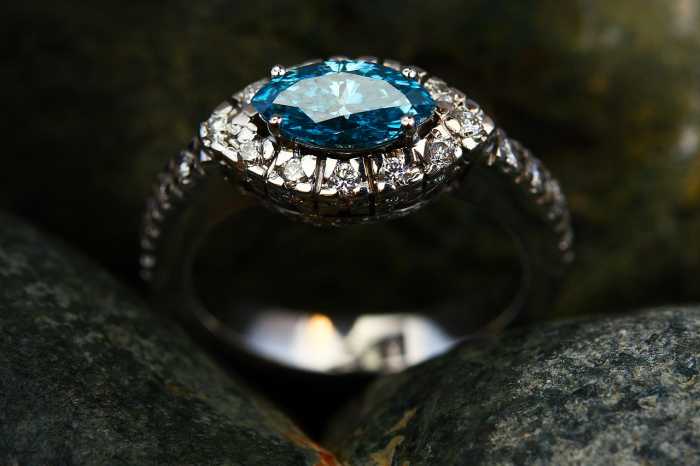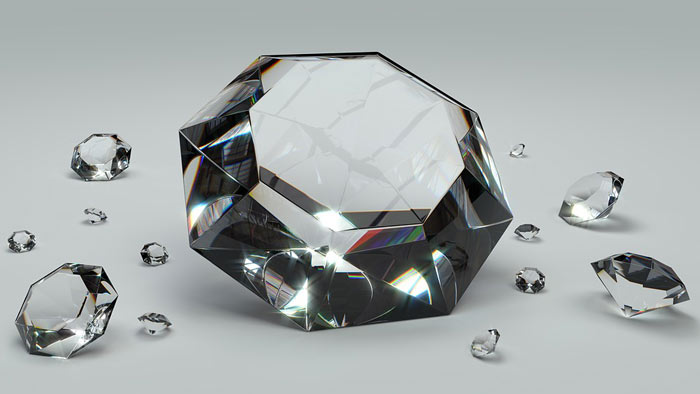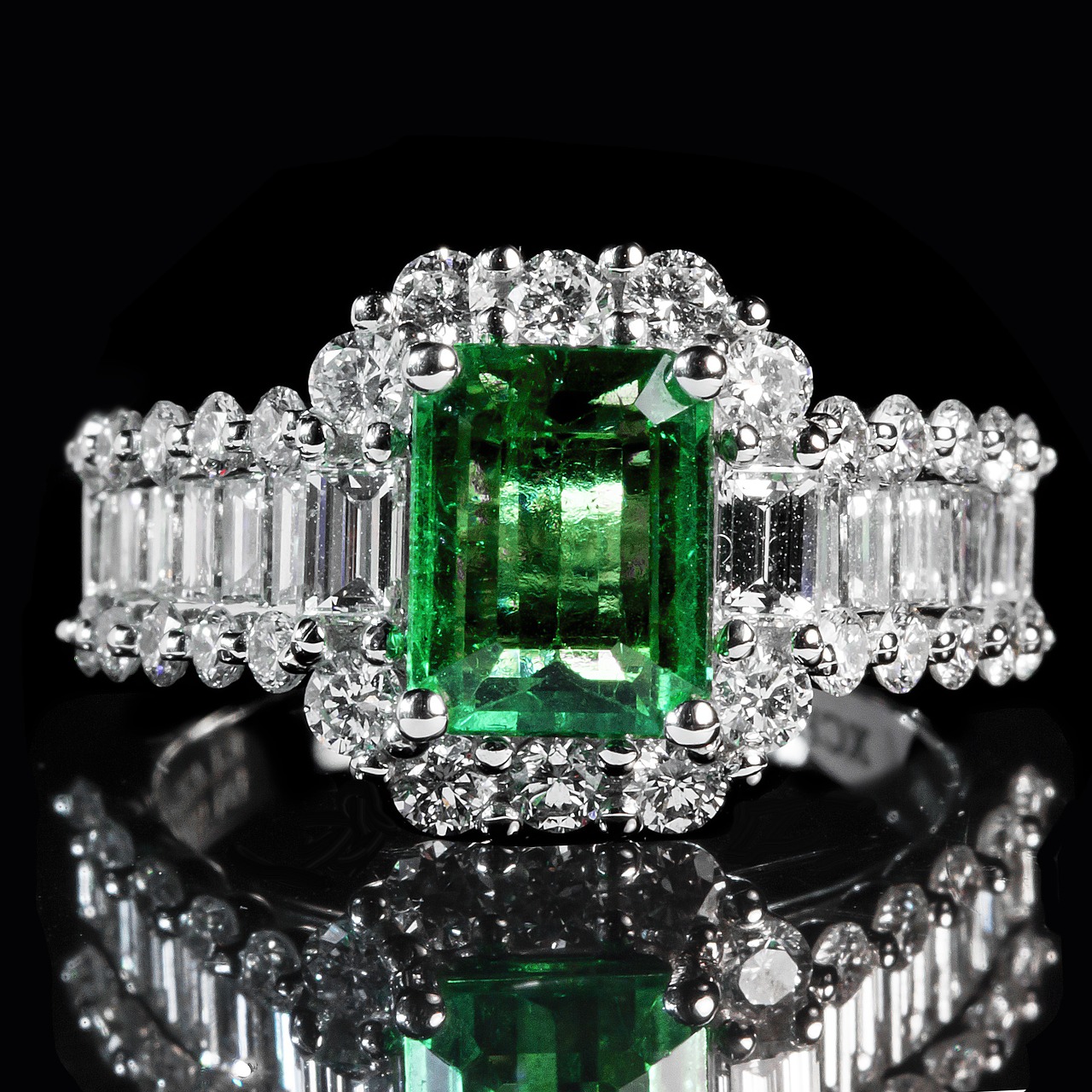80-90% of all colored gemstones are mined by artisanal and small-scale designers. In today’s home-grown, organic universe, the bright, unique appeal of homegrown gemstones is taking on a new popularity. Colored engagement rings are striking, romantic, and replete with hidden meanings. Yet buying gemstone jewelry is an investment. What should you be looking for when you shop? Here’s what you need to know.

1. Color
Colored gemstones use the same 4 C’s as diamonds to judge the quality (color, clarity, cut and carat.) The difference is the value placed on each element.
With colored gemstones, for example, color is the most important factor. With diamonds, it is usually the cut.
The hue describes the dominant color, as well as any additional colors visible within the gem.
The six primary hues are violet, blue, green, yellow, orange, and red. Secondary hues like blue-green are present between the primary hues. The most valuable gems are those with pure primary colors.
Tone refers to the lightness or darkness of a color. Tones range from light and clear to dark and deep.
Saturation refers to the purity of the color present in the stone. A gemstone with excellent saturation has a pure color that is uninterrupted by tints.
2. Cut
When they are cutting gemstones, artisans aim for the right balance of color, weight, and shape.
Oftentimes, multiple facets get cut into a gem in order to help the stone amplify light and appear even more brilliant.
The style of cut may get altered depending on the stone available. Sapphires and emeralds, for example, lend themselves to a more faceted cut. Opals are best suited to a smooth, round surface.
One popular cut is a step cut, which uses rectangular and square facets to create a deep, mirror-like look. This gets used often on baguette and emerald gemstones.
A brilliant-cut can get used on round or square gemstones. It is popular because of how much it makes gemstones sparkle. Brilliant cuts take advantage of the optical properties of stones.
3. Clarity

Clarity refers to the way light moves through gemstones, affecting their beauty. Many gemstones have natural inclusions or foreign objects that have been included in a gemstone during its formation.
4. Carat
Carat is the measure of the weight of your precious stone. Because each stone gets made up of a different mineral, density will vary from stone to stone.
Generally, stones that are heavier will be more expensive. Some stones are rarely found in larger sizes, so you can expect to pay a high price for them. These include rubies, garnets, and emeralds.
5. Mohs Scale
The Mohs scale uses hardness to classify minerals. It measures a stone’s resistance to scratching or abrasion.
If you plan to wear a gemstone a lot, you will want to look for a high Mohs rating. A ring you will wear every day, or a bracelet you will wear playing tennis, will require a more sturdy gem.
A precious pendant you may only wear occasionally, however, may be suitable for a stone with a lower Mohs rating.
6. Organic Gemstones
Organic gemstones are those that have been made from minerals and plants. Popular organic gemstones and birthstones include amber, pearl, and ivory.
Mineral gemstones get mined from the earth. This category includes many stones that were traditionally classified as precious, such as diamonds, rubies, and emeralds.
7. Round Cut

The shape of a gemstone is distinguished from its cut. A stone’s shape refers to the style it gets molded into before it is sold.
The round cut is one of the most popular. it has an exceptional white light reflection. Colored light is brilliantly dispersed in a round-cut, giving it rare clarity and beauty. Round cuts complement casual as well as formal styles.
8. Princess-Cut
Princess cut stones are uniquely shaped for sparkle. Diamonds cut in this shape may show more color than round cuts.
Princess cut rings and earrings are perfect for trendy styles.
9. Oval-Cut
Oval cut stones tend to be less expensive because they are less popular. They share the brilliance and sparkle of other round gemstones shapes.
Oval diamonds have a long, elegant shape and can make fingers look longer. There are no sharp cuts on an oval, so an oval-cut ring is great for everyday wear.
10. Pear-Shaped
Pear-shaped stones actually look longer than traditional gemstones because of their elongated shape. They can also cost less.
Pear-shaped stones are versatile and work great with vintage, modern, and classic looks.
11. Marquis Cut
Marquis cut stones are softly curved with pointed ends. They are less expensive and look longer than round cuts. Marquis cuts can elongate your fingers as well.
12. Emerald-Cut

An emerald-cut gem is square with clipped corners, making it an excellent option if you can’t choose between a round or square cut. The long facets in this shape provide bright, sustained flashes. Their corners give them greater durability than square shapes.
Emerald-cut stones are less in demand and therefore can be a bit less expensive.
13. Heart-Shaped
Heart-shaped stones are popular on rings, pendants, and bracelets. They create a unique symmetry while offering value for your money. This shape is best in weights of one carat or more for maximum visibility.
What To Remember When Buying Gemstone Jewelry
Buying gemstone can be confusing. With a little knowledge of factors like shape, cut, color, and clarity, you will find a piece you will wear and treasure for years to come.
For more jewelry tips, read our blog today.











